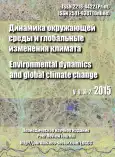Immigration of European beaver in State Nature Reserve "Yuganskiy" area
- Authors: Pereyaslovets V.M1
-
Affiliations:
- State Nature Reserve “Yugansky”
- Issue: Vol 6, No 2 (2015)
- Pages: 12-16
- Section: Articles
- Published: 15.12.2015
- URL: https://edgccjournal.org/EDGCC/article/view/6364
- DOI: https://doi.org/10.17816/edgcc6212-16
- ID: 6364
Cite item
Full Text
Abstract
At present, the European beaver ( Castor fiber Linnaeus, 1758) is swiftly expanding its range within Russia. The main reason of this natural phenomenon is the reacclimatization of beavers in their historical habitats. The steady increase in beaver population resulted in the beginning of natural dispersion. Beaver is a plastic species which can survive even in severe climatic conditions. The state nature reserve "Yugansky" is located in the Surgut district, with an area of 648,636 hectares. In the past the reserve's territory was inhabited by the indigenous West Siberian Beaver ( Castor fiber pohlei Serebrennicov, 1929). The last individuals of this species were observed in the area over 100 years ago. In the middle of the twentieth century areas adjacent to the reserve were repopulated with beavers from the European population. The reacclimatization was successful. A new population began an intensive colonization in the surrounding area. The nature reserve "Yugansky" is situated between the Bolshoy Yugan and Maliy Yugan rivers. The beaver population expands along these rivers and their tributaries. The first migratory beavers appeared in the vicinities of the reserve in 1990. In ten years, they occupied several sites in the basin of the Bolshoy Yugan river 25 kilometres down from the southern border of the reserve. In December 2012 the first beaver settlements were found in the southern parts of reserve. Animals settled in the upper stream of the Magromsy river and the Yakkunyah river, two right tributaries of the Bolshoy Yugan river. Staff researches from the reserve discovered three beaver settlements. Immigration of the beavers on the territory of the "Yugansky" reserve occurred in its southern boundary. The animals penetrated the reserve territory to a depth of 2 to 6 km and section width of about 33 km. The beaver settlements in the reserve are located in densely forested, remote and virtually inaccessible areas. At present, there are two beaver settlements located on the Aymagromsy river and Entlpunigl river. The beavers have survived two winters. We have observed numerous signs of feeding and construction activity along the banks of these rivers. The animals built several dams, and there are many felled trees along the banks. Beavers mostly feed on birch trees with the diameter of 5 to 40 centimeters. They eat aspen, various kinds of willows, bird cherry and other shrubs as well. No lodges were not found. The beavers use discreet bank dens as refuge. We observed numerous channels and trails along the banks made by beavers. In the future, a stable population of beavers is likely to form in the state nature reserve "Yugansky".
About the authors
Vladimir M Pereyaslovets
State Nature Reserve “Yugansky”
Author for correspondence.
Email: pvm16@yandex.ru
Russia, Ugut
References
- Бобров В.В., Варшавский А.А., Хляп Л.А. 2008. Чужеродные виды млекопитающих в экосистемах России. М.: Товарищество научных изданий КМК. 232 с.
- Васильев В.В. 1929. Река Демьянка: экономическо-этнографический очерк. Тобольск: Тобольская гостипография. 36 с.
- Васин А.М. 1985. К проблеме сохранения аборигенных сибирских бобров // Млекопитающие в системе природопользования на Урале (Проблемы териологии на Урале). Свердловск: изд-во УНЦ АН СССР. С.12-14.
- Васин А.М., Воробьев В.Н. 2012. Кондо-Сосьвинские бобры // Современные проблемы природопользования, охотоведения и звероводства. №1. С.508-509.
- Жданов А.П. 1969. Современное состояние бобровых очагов в Западной Сибири, перспективы роста в них численности зверей и возможности хозяйственного использования отдельных популяций // Восстановление и рациональное использование запасов речного бобра в СССР. Труды Воронежского заповедника. Воронеж. Вып.XVI. С.126-137.
- Кириков С.В. 1966. Промысловые животные, природная среда и человек. М.: Наука. 349 с.
- Павлов М.П., Корсакова И.Б., Тимофеев В.В., Сафонов В.Г. 1973. Акклиматизация охотничье-промысловых зверей и птиц в СССР. Ч.1. Киров: Волго-Вятское изд-во. 534 с.
- Чугунов С.М. 2007. Млекопитающие и птицы Сургутского уезда, собранные летом 1913 года. Репринтное издание. Екатеринбург: Баско. 376 с.
Supplementary files










